The Jerusalem Water Aqueduct 12km from the Solomon's Pools
Introduction:
1. The Letter of Aristeas gives us solid proof that the aqueduct was in full operation as early as 278 BC.
a. This proves that the Hasmoneans (100 BC) and Romans (18 BC) were not the first builders of the water system, but mere renovators of an earlier design and build.
b. This is good evidence that Solomon was in fact the original designer and builder of the water system from Etam to his Jerusalem temple.
2. The Gihon Spring is the only water source inside Jerusalem.
a. A system of 5 aqueducts that supplied water to Jerusalem and the temple has been discovered.
b. A major water supply system started in the hill country that fed three large rectangular reservoirs in Etam known as "Solomon's pools".
c. "The three reservoirs, which are somewhat rectangular in shape, are placed consecutively at successive levels. They vary in size, with the highest the smallest and the lowest the largest. The lower pool is 582 feet long, 148 to 207 feet wide, and 50 feet deep. The small pool is also the most shallow, having a depth of only 15 feet. The estimated capacity of all three is about 40,000,000 gallons." (Pools of Solomon, Baker Encyclopedia of the Bible, 1988 AD)
3. Solomon may have originally dug one or all three pools at Etam and the first aqueduct to feed his new temple in Jerusalem.
a. "I made ponds of water for myself from which to irrigate a forest of growing trees." (Ecclesiastes 2:6)
b. "The king [Solomon] himself rode upon a chariot in the midst of these men, who were still in armor, and had their bows fitted to them. He had on a white garment, and used to take his progress out of the city in the morning. There was a certain place, about fifty furlongs distant from Jerusalem, which is called Etam, very pleasant it is in fine gardens, and abounding in rivulets of water; thither did he use to go out in the morning, sitting on high [in his chariot]. (Josephus, A ntiquities 8.186)
c. Letter of Aristeas, 278-150 BC: The water aqueduct from Etam to the temple in Jerusalem is described in detail
i. The letter of Aristeas is a Pseudepigrapha, meaning that it was written by a real person who deceptively represented himself as an historic person, from an earlier time in history. It would be like someone living today, composing a letter, dating it to 1864 AD and signing it Abraham Lincoln. In the same way the Jewish author of the Letter of Aristeas represents himself as Egyptian courtier living 100 years earlier.
ii. Letter of Aristeas, therefore is a Pseudepigrapha written by Alexandrian Jew in 150 BC, claiming to be written by Egyptian courtier in the reign of Ptolemy Philadelphus II (285-257 BC) during the lifetime of Queen Arsinoe (278-270 BC). It is the earliest reference to the Septuagint (LXX) and documents Ezekiel 17:15 where king Zedekiah sends troops in 593 BC to Psammetichus II (Psamtik II), king of Egypt 595-589 BC.
iii. Now the letter was written in 150 AD, so clearly the aqueduct was in existence at that time, but since he was writing as if it was 285 BC, it means that the aqueduct was also surely in full operation then too.
iv. So it is clear, that the aqueduct was in full operation as far back as 278 BC
v. "I have given you this description of the presents because I thought it was necessary. The next point in the narrative is an account of our journey to Eleazar, but I will first of all give you a description of the whole country. When we arrived in the land of the Jews we saw the city situated 84 in the middle of the whole of Judea on the top of a mountain of considerable altitude. On the summit the temple had been built in all its splendour. It was surrounded by three walls more than seventy cubits high and in length and breadth corresponding to the structure of the edifice. All the buildings 85 were characterized by a magnificence and costliness quite unprecedented. It was obvious that no expense had been spared on the door and the fastenings, which connected it with the door-posts, and 86 the stability of the lintel. The style of the curtain too was thoroughly in proportion to that of the entrance. Its fabric owing to the draught of wind was in perpetual motion, and as this motion was communicated from the bottom and the curtain bulged out to its highest extent, it afforded a pleasant 87 spectacle from which a man could scarcely tear himself away. The construction of the altar was in keeping with the place itself and with the burnt offerings which were consumed by fire upon it, and the approach to it was on a similar scale. There was a gradual slope up to it, conveniently arranged for the purpose of decency, and the ministering priests were robed in linen garments, down to their 88 ankles. The Temple faces the east and its back is toward the west. The whole of the floor is paved with stones and slopes down to the appointed places, that water may be conveyed to wash away the 89 blood from the sacrifices, for many thousand beasts are sacrificed there on the feast days. And there is an inexhaustible supply of water, because an abundant natural spring gushes up from within the temple area. There are moreover wonderful and indescribable cisterns underground, as they pointed out to me, at a distance of five furlongs all round the site of the temple, and each of them has countless pipes 90 so that the different streams converge together. And all these were fastened with lead at the bottom and at the sidewalls, and over them a great quantity of plaster had been spread, and every part of the work had been most carefully carried out. There are many openings for water at the base of the altar which are invisible to all except to those who are engaged in the ministration, so that all the blood of the sacrifices which is collected in great quantities is washed away in the twinkling of an 91 eye. Such is my opinion with regard to the character of the reservoirs and I will now show you how it was confirmed. They led me more than four furlongs outside the city and bade me peer down towards a certain spot and listen to the noise that was made by the meeting of the waters, so that the great size of the reservoirs became manifest to me, as has already been pointed out." (R.H. Charles-Editor, Oxford: The Clarendon Press, 1913) (Letter of Aristeas 83-91, Pseudepigrapha of Greek Court-official 278-270 BC. Actual: Written by Jew in 150 BC)
4. There is another pool called "Solomon's pool" in Jerusalem that Josephus mentions:
a. "But if we go the other way westward, it began at the same place, and extended through a place called “Bethso,” to the gate of the Essenes; and after that it went southward, having its bending above the fountain Siloam, where it also bends again towards the east at Solomon’s pool, and reaches as far as a certain place which they called “Ophlas,” where it was joined to the eastern cloister of the temple." (Josephus, Wars of the Jews 5.145)
4. These pools or a single pool at Etam AND an aqueduct to feed the temple, may have been built by Solomon.
a. While the archeology surrounding the "pools of Solomon" and the aqueducts dated to the Hasmonean and Early Roman Periods (100-10 BC) it is very likely that these were remodeling and upgrading projects of older systems that may well have dated back to the time of Solomon.
i. Archeologists can verify Hasmonean and Roman involvement in the pools and aqueduct but this does not rule out the possibility that Solomon was the first builder.
ii. In excavations the Byzantines would rebuild on older sites by scraping everything down to bedrock leaving little or no evidence of the previous occupation level.
iii. "The original Lower Aqueduct is dated to the Hasmonean period (mid 2nd – mid 1st c. BC). Thus, along with one or more of the Solomon’s Pools, it is (in its original form) the oldest part of Jerusalem’s aqueduct system. Its construction was meant to alleviate the water shortage that arose at that time in Jerusalem, since the springs and pools in the city were not sufficient for the needs of the growing population and the myriads of pilgrims visiting the Temple." (Solomon’s Pools and relating aqueducts, the heart of Jerusalem’s past water supply, Hydria project, 2009 AD)
b. If you were going to upgrade, repair or replace on older aqueduct, you would simply dig up the old one and since the sections cut in stone and basic level were already easy to follow.
c. To argue that the three pools at Etam and the aqueduct do not date back to Solomon, overlooks the fact that after 900 years the aqueducts may have been replaced several time and all we find today are the last renovation project.
5. Hasmonean's build aqueduct:
a. "In order to guarantee the water supply of the Temple, the Hasmoneans built the first aqueduct to Jerusalem. It is now called the “low-level aqueduct.” The channel is still visible at many points and it dropped only 30 m in its 21.5 km course from Solomon’s Pools south of Bethlehem to the Temple." (The New Interpreter’s Dictionary of the Bible, Volume 3, Page 251)
6. Wilson's Arch was an aqueduct:
a. "As was correctly recognized almost from the moment of its discovery, Wilson’s Arch supported a bridge that led from the Temple Mount west across the central valley (identified by the first-century Jewish historian Josephus as the Tyropoeon Valley, or, in an incorrect translation, the Valley of the Cheesemakers) to the western hill of the city. But the purpose of the bridge, as indicated by the aqueduct still running above it, was to convey water; it was not principally for human traffic. It was built by Herod the Great late in the first century B.C.E. to replace an earlier bridge built, as we are told by Josephus, by the Maccabean rulers and destroyed during Pompey’s conquest of Jerusalem in 63 B.C.E. The source of the water was about 15 miles south of Jerusalem, on the other side of Bethlehem, where spring water is collected in three large pools called, incorrectly, Solomon’s Pools. From there water flows north through a channel, which can still be easily traced, directly to the Temple Mount for priestly use. (Not a single tributary channel leads off the main channel; every drop was reserved for priestly use on the Temple Mount. This gives some idea of the enormous amount of activity that occurred on the Temple Mount at that time.)" (Jerusalem Down Under: Tunneling Along Herod’s Temple Mount Wall, Dan Bahat, 21:06, Nov/Dec 1995)
b. Amihai Mazar, “The Aqueducts of Jerusalem,” in Yigael Yadin, Jerusalem Revealed (Jerusalem: Israel Exploration Society, 1975), pp. 79–84.
7. Pilate upgraded or built a new aqueduct from the Etam pools 40 km away:
a. "But Pilate undertook to bring a current of water to Jerusalem, and did it with the sacred money, and derived the origin of the stream from the distance of two hundred furlongs [40 km]. However the Jews were not pleased with what had been done about this water; and many ten thousands of the people got together, and made a clamor against him, and insisted that he should leave off that design. Some of them also used reproaches, and abused the man, as crowds of such people usually do." (Josephus, Antiquities 18.60)
8. Jehoshaphat assembled his army in the valley of Berachah [Hebrew = Blessing/pools] which may have been at the pools of Solomon.
a. Berachah can be translated: "Valley of the pools".
b. "Pools of Solomon—the name given to three large open cisterns at Etam, at the head of the Wady Urtas, having an average length of 400 feet by 220 in breadth, and 20 to 30 in depth. These pools derive their chief supply of water from a spring called “the sealed fountain,” about 200 yards to the north-west of the upper pool, to which it is conveyed by a large subterranean passage. They are 150 feet distant from each other, and each pool is 20 feet lower than that above it, the conduits being so arranged that the lowest, which is the largest and finest of the three, is filled first, and then in succession the others. It has been estimated that these pools cover in all a space of about 7 acres, and are capable of containing three million gallons of water. They were, as is generally supposed, constructed in the days of Solomon. They are probably referred to in Eccles. 2:6. On the fourth day after his victory over the Ammonites, etc., in the wilderness of Tekoa, Jehoshaphat assembled his army in the valley of Berachah (“blessing”), and there blessed the Lord. Berachah has been identified with the modern Bereikut, some 5 miles south of Wady Urtas, and hence the “valley of Berachah” may be this valley of pools, for the word means both “blessing” and “pools;” and it has been supposed, therefore, that this victory was celebrated beside Solomon’s pools (2 Chr. 20:26). These pools were primarily designed to supply Jerusalem with water. From the lower pool an aqueduct has been traced conveying the water through Bethlehem and across the valley of Gihon, and along the west slope of the Tyropoeon valley, till it finds its way into the great cisterns underneath the temple hill. The water, however, from the pools reaches now only to Bethlehem. The aqueduct beyond this has been destroyed." (Pools of Solomon, Easton’s Bible Dictionary, 1893 AD)
The Jerusalem Temple Water supply: A 12km aqueduct from the Solomon's Pools in Etam to Jerusalem.
1.
Solomon built a complex water aqueduct system from
Hebron, through Bethlehem to Jerusalem in about 950 BC. Evidently this water
system was incorporated as a major design of the Temple itself. Solomon knew
that the Gihon spring in the city of David did not have enough "head"
(water pressure or lift) to supply the Temple above. Water would be a major
need to wash the blood away and keep the area from putrefying. A large water
supply would be needed. Solomon's pools are about 12 km south east of the
Jerusalem.
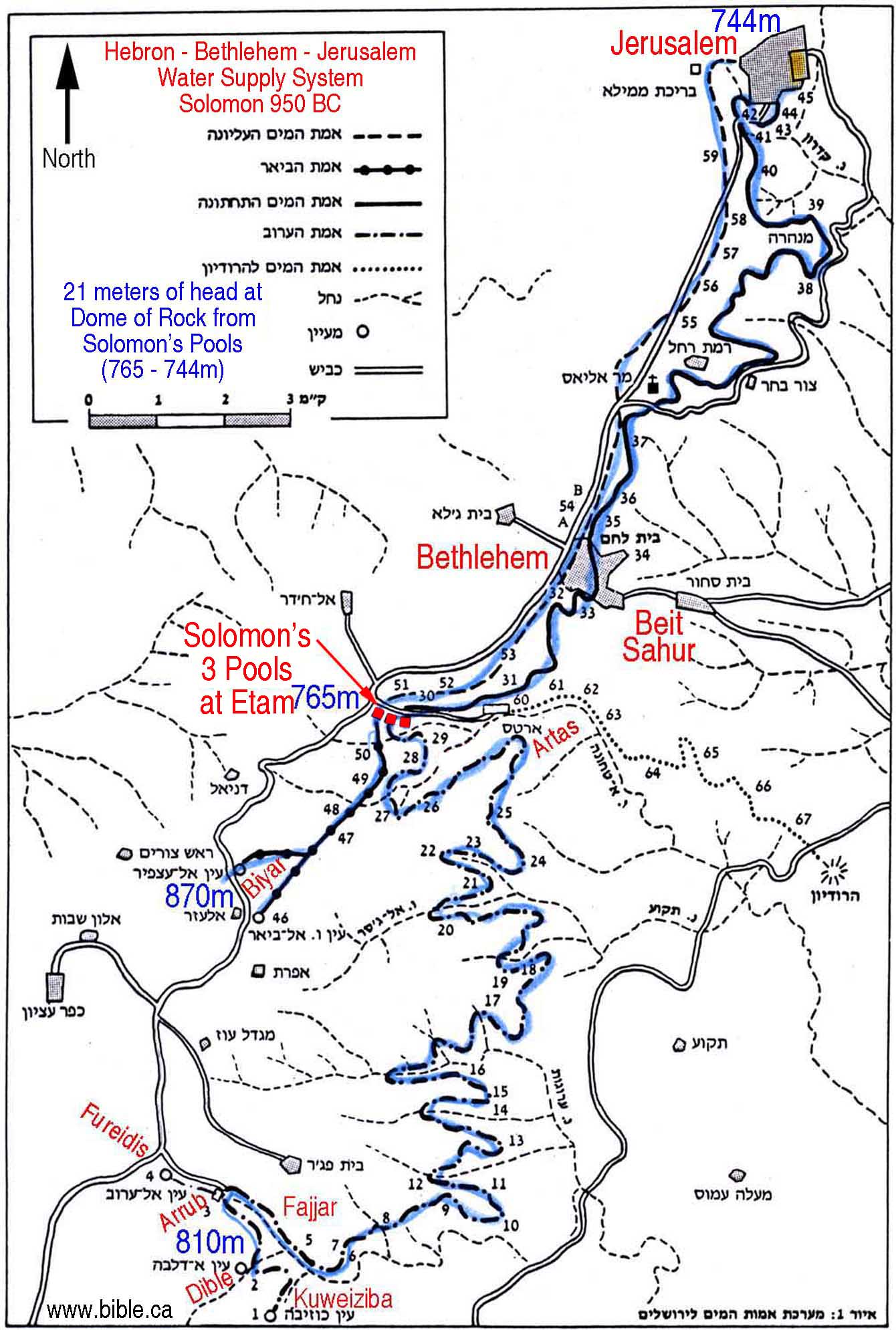
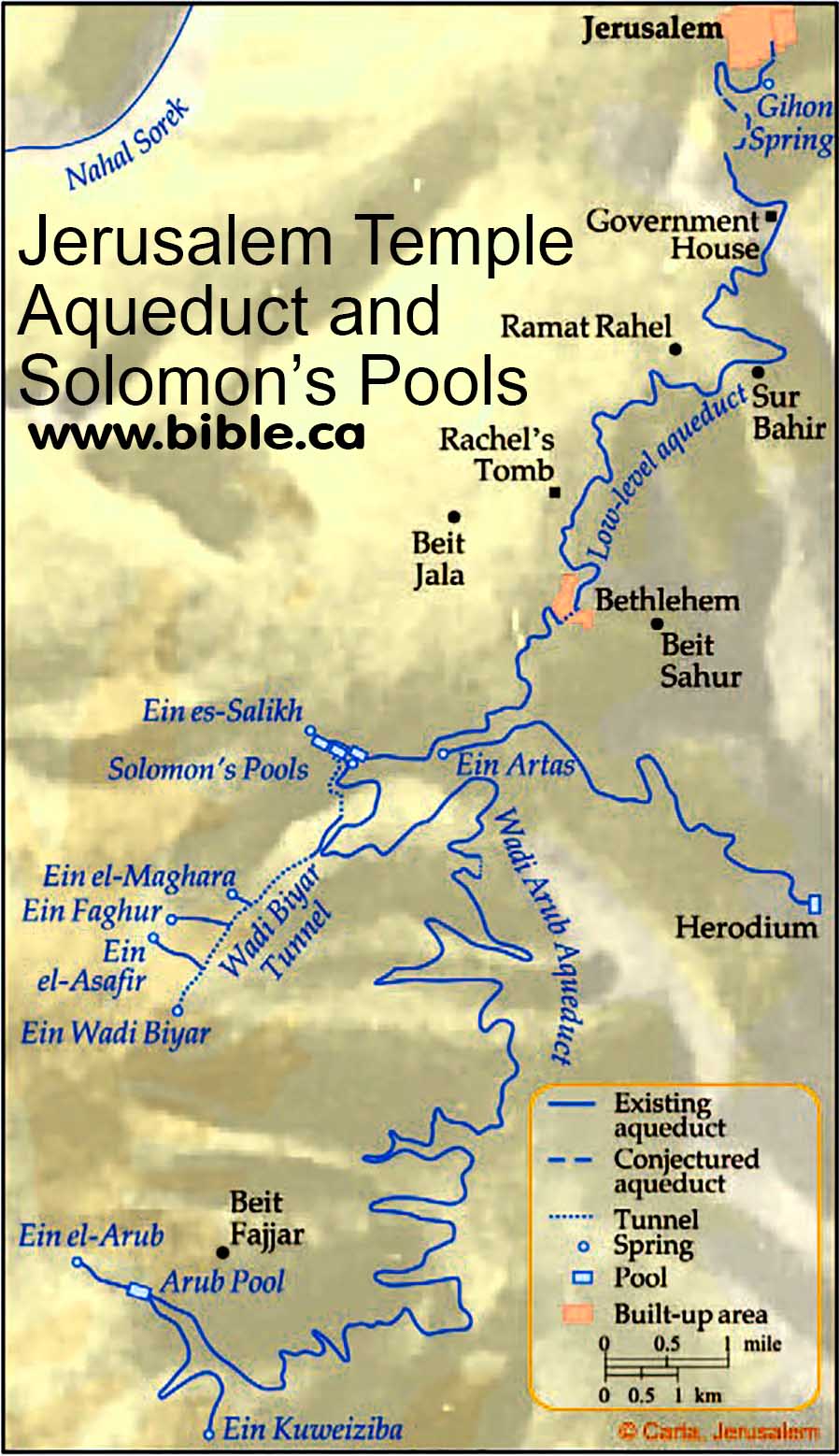
2.
The water conduit that supplied the temple in Jerusalem
began in the area of the Hebron mountains, passed through Solomon's Pools at
Etam, near Bethlehem, and flowed to Jerusalem. Here is an photo of the three
pools Solomon built as holding tanks for the water that was collected from the
Hebron mountains upstream:
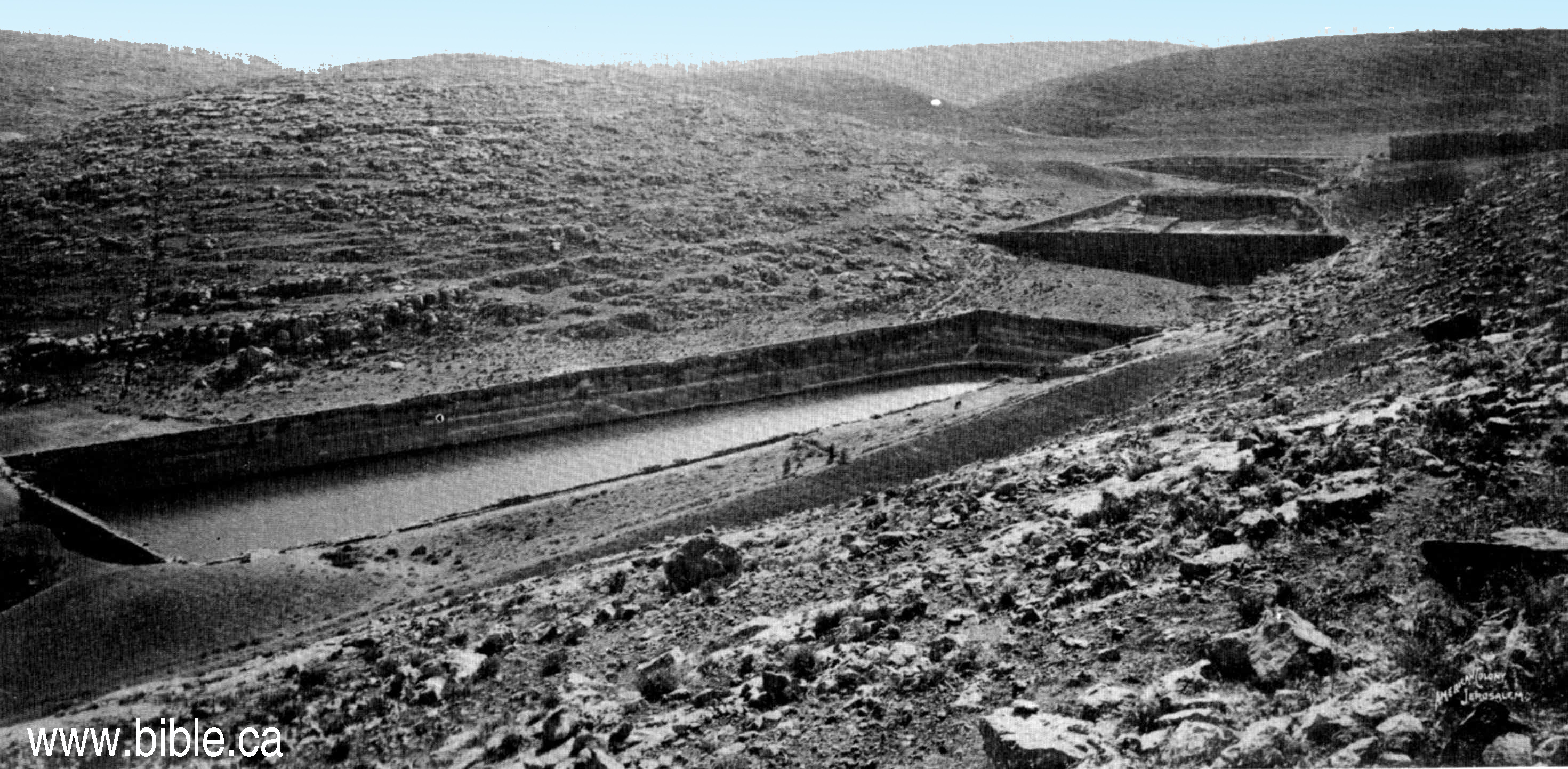
3. To get the water from the Solomon's Pools to Jerusalem a special aqueduct had to be built. Here are two photos of that aqueduct. One is actually looking inside a portion of the aqueduct that is still buried where Solomon built it. The second photo is of two rock carved sections of Solomon's aqueduct in the Rockefeller Museum today. The individual sections were buried then sealed so they were water tight. This way they could actually create a siphon that would traverse down the valleys and back up again.
a.
Upper Aqueduct. In the second century A.D. the Tenth Roman
Legion constructed an aqueduct (seen below in two sections at Rockefeller
Museum) to bring water from Solomon’s Pools to the Roman camp near Jerusalem’s
Jaffa Gate. Stone pipe sections of this aqueduct, called the Upper Aqueduct to
distinguish it from the Low Level Aqueduct built earlier by the Hasmoneans,
originally covered over a mile of the journey to Jerusalem; they survive only
in a few segments."
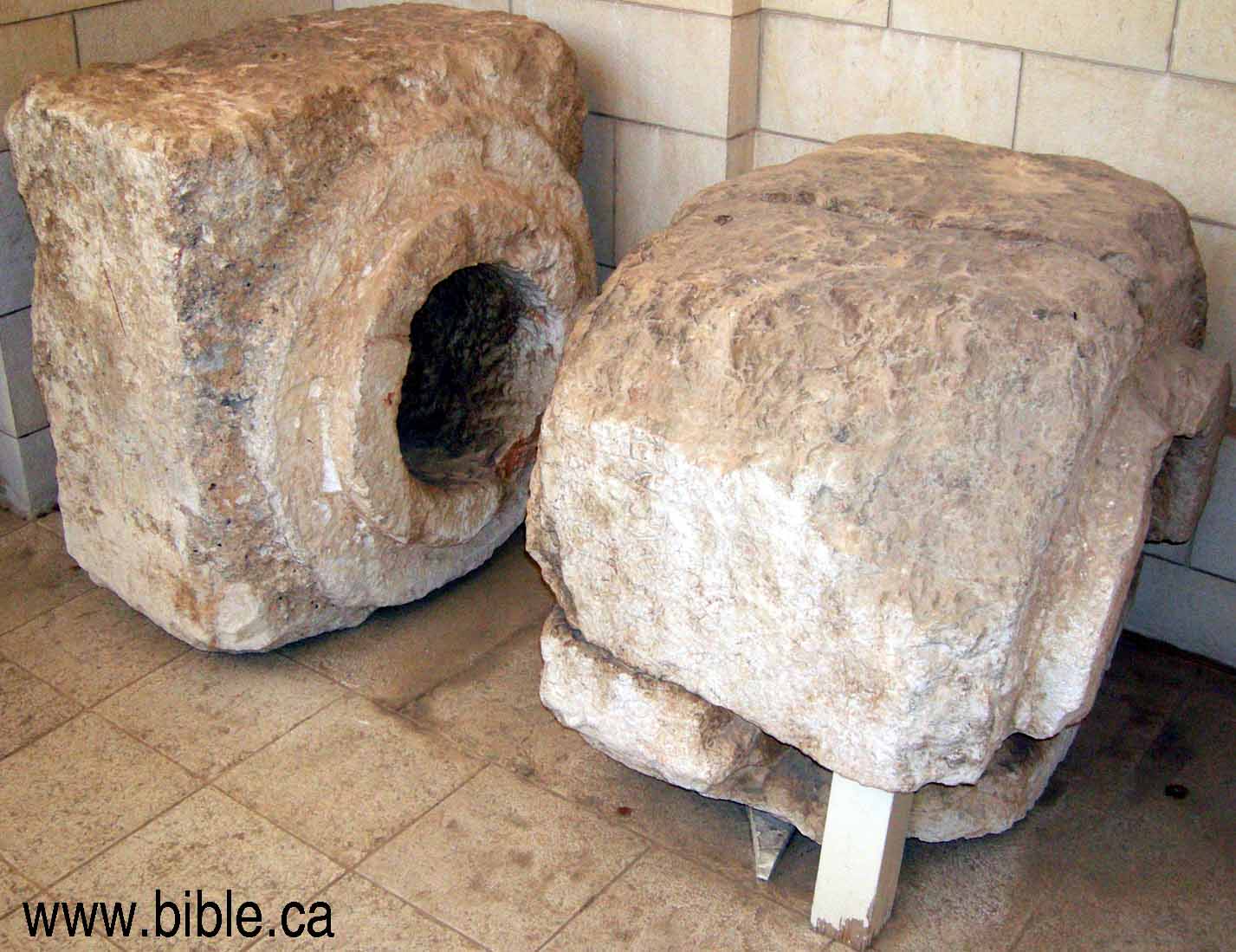
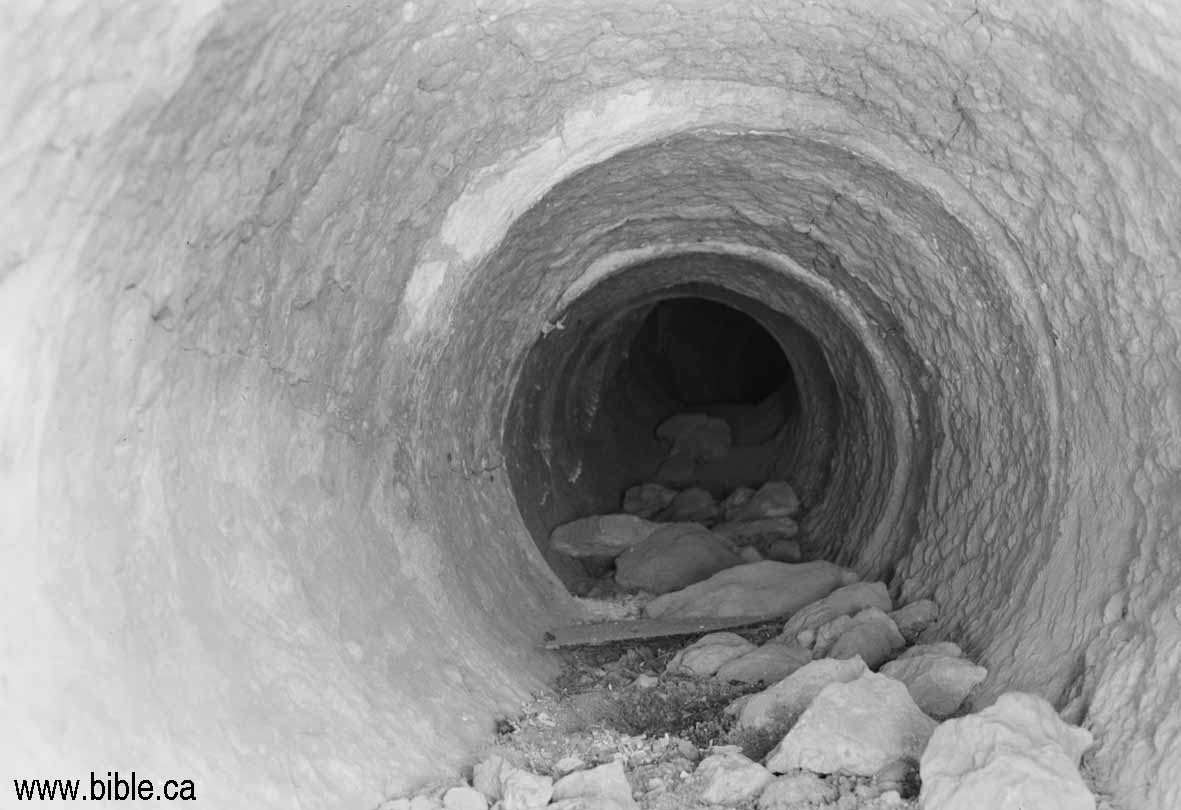
4.
The use of a sealed siphon system is like a water hose.
Lets say you want to drain your above ground swimming pool in your back yard.
You stick the one end of the hose in the pool and the other on the ground. The
net different of "head" is determined by the height difference
between the level of the water in the pool and where the water leaves the hose.
As you lift the hose from the ground to the top of the water in the pool, the
water flow rate diminishes, then stops when there is no difference in
elevation. Municipal water towers use exactly the same principle are only used
when there is a power failure and the electric pumps cannot create the water
pressure. In the event of a power failure, they immediately start drawing water
from the water tower, which because it is 100 feet in the air, creates enough
water pressure (head) to makes the taps flow until the electric power is
restored. It doesn't matter how high or low the water hose is in the middle, as
long as the place the water comes out is lower than where the water enters. In
this way they could get water all the way from just north of Bethlehem about 10
miles to Jerusalem to supply the Temple with all the water it needed to wash
away the blood from the sacrifices. Here is a section of that water conduit
that can be seen near Solomon's Pools that feeds water from Ein Arrub Springs
near Hebron:
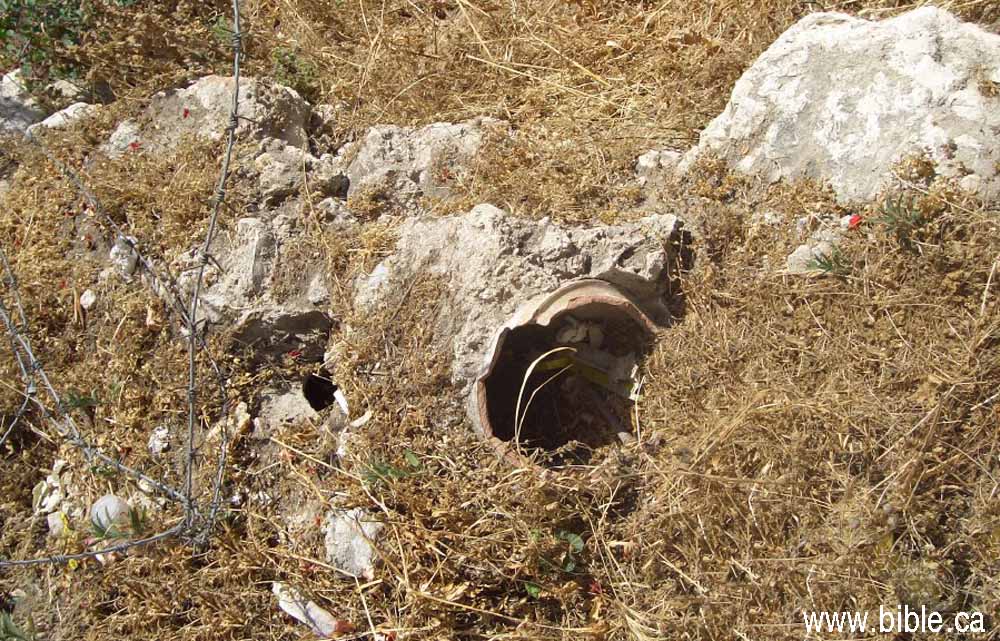
5.
The lowest of two aqueducts reached the Temple Mount
through the Jewish Quarter and the Wilson Bridge. According to the ancient
authorities, the this aqueduct supplied water to the High Priests' mikveh
(ritual bath) located above the Water Gate, and it also supplied water for the
rinsing of the blood off the Azarah. Solomon's water system would supply this.
We can see that there was significant potential water pressure with 21 meters
of gross head at the highest point of the temple mount. The level at Solomon's
Pools near Bethlehem is 765 meters above sea level. The level at the top of the
Rock under the Dome is 744 meters. We know Solomon used a sealed conduit
system, so we know there was ample water pressure to supply lots of water to
the temple mount based on the laws of physics including a friction loss
calculation. Its really that simple. Imagine a water tower installed on the
temple platform that is 21 meters (69 feet) in the air. This would give
excellent water pressure at about 30 PSI (Pounds per square inch). Our modern
city water pressure is about 60-70 PSI.
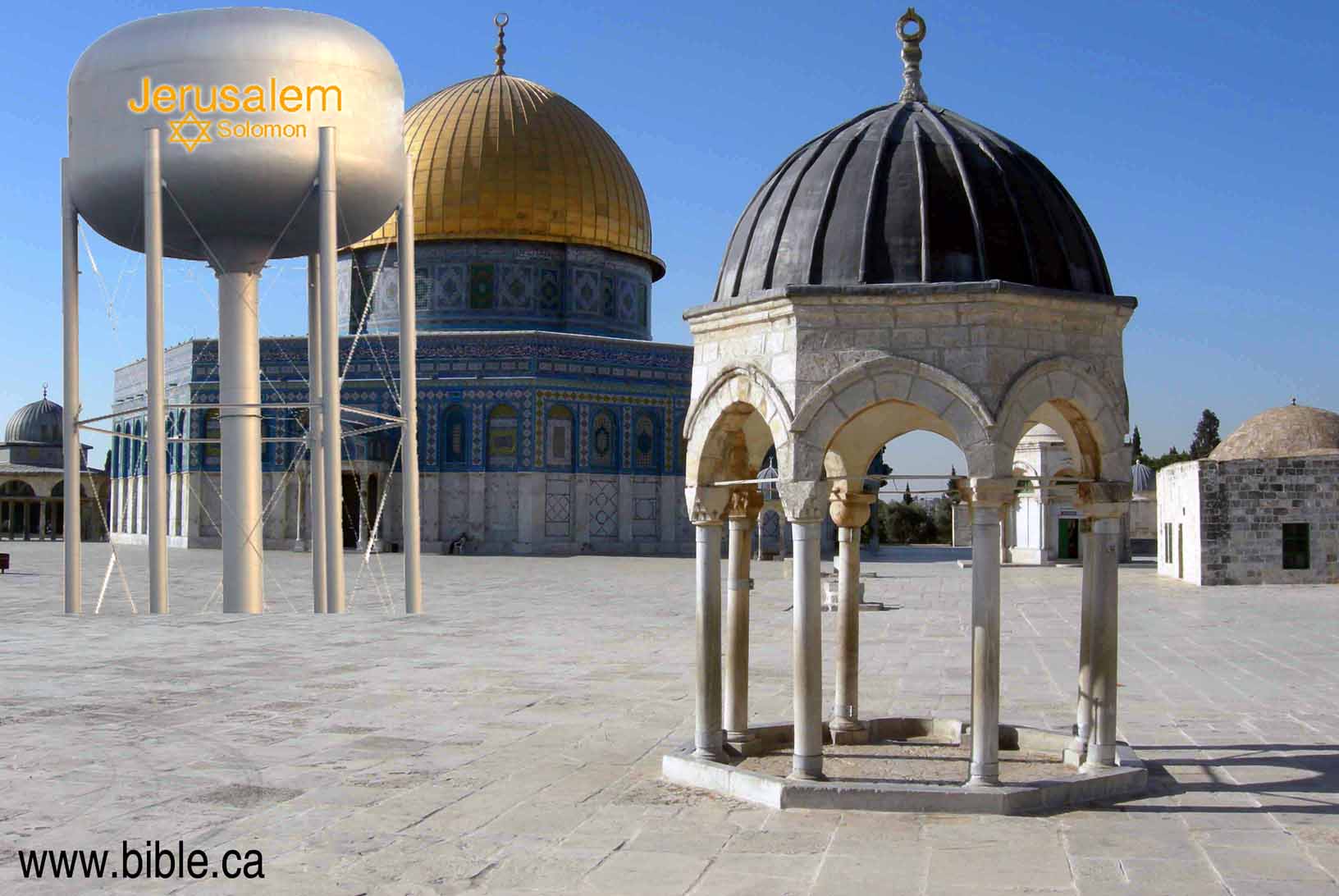
6. "Living water" non biblical: The idea that the temple area must be washed with "Living water," (from a spring) rather than from a cistern is not biblical. However later manmade traditions and rules were added to the law of Moses that were incorporated into temple worship. God doesn't care if the water is from a spring or from pots carried on people's heads. If He did care, God would have told us in the Bible and He didn't! When Jesus was falsely accused of uncleanness by the Pharisees for eating with unwashed hands, Jesus condemned them: "The Pharisees and some of the scribes gathered around Him when they had come from Jerusalem, and had seen that some of His disciples were eating their bread with impure hands, that is, unwashed. (For the Pharisees and all the Jews do not eat unless they carefully wash their hands, thus observing the traditions of the elders; and when they come from the market place, they do not eat unless they cleanse themselves; and there are many other things which they have received in order to observe, such as the washing of cups and pitchers and copper pots.) The Pharisees and the scribes asked Him, "Why do Your disciples not walk according to the tradition of the elders, but eat their bread with impure hands?" And He said to them, "Rightly did Isaiah prophesy of you hypocrites, as it is written: 'This people honors Me with their lips, But their heart is far away from Me. 'But in vain do they worship Me, Teaching as doctrines the precepts of men.' "Neglecting the commandment of God, you hold to the tradition of men." He was also saying to them, "You are experts at setting aside the commandment of God in order to keep your tradition." (Mark 7:1-9) The "living water" rule is just another example of what Jesus was talking about. If God wanted the priests to only use "running spring water" at the temple, he would have told us this in the Bible.
7. Temple not located Over the Gihon Spring: Ernest Martin believes the only way to harmonize the need for "living water" is to locate Solomon's temple directly over the Gihon Spring in the City of David. Remember that the temple site was first used as a threshing floor that David purchased from Ornan the Jebusite (1 Chronicles 21:18-29). Remember also, that the Gihon spring was Jerusalem's only natural water supply for a 5 mile radius. Threshing floors were never placed near springs of water, for the same reason you don't put a toilet in the middle of your dinner table. (read more why) Solomon built the temple over a threshing floor, nowhere near the Gihon Spring. Need we remind them that the whole idea of "living water" at the temple is also not found in the Bible?.
8.
There are several places where the end of Solomon's
ancient aqueduct pipes can be seen in the temple mount area. The one that is
believed to supply the water to the Temple is broken off at a level of 737
meters. Because this is well below the platform that the Dome of the Rock
currently sits on at 742 meters, some believe this is proof that the temple
mount platform was about 18 meters lower in the past, than it is today. Of
course, this idea demands that the temple be located over the Al-Kas fountain
because the Dome is already sitting on bedrock, but you can dig down 60 feet
below the fountain. Here are two places you can still see the end of Solomon's
conduit very near the temple mount. These two photographs were taken by Steve
Rudd on the stairs that lead from the upper streets down to the Wailing wall.
If you visited Jerusalem and the wailing wall, YOU PASSED right by these but
didn't know it! They are only 10 feet from the walkway as you descend down to
the level of the wailing wall.
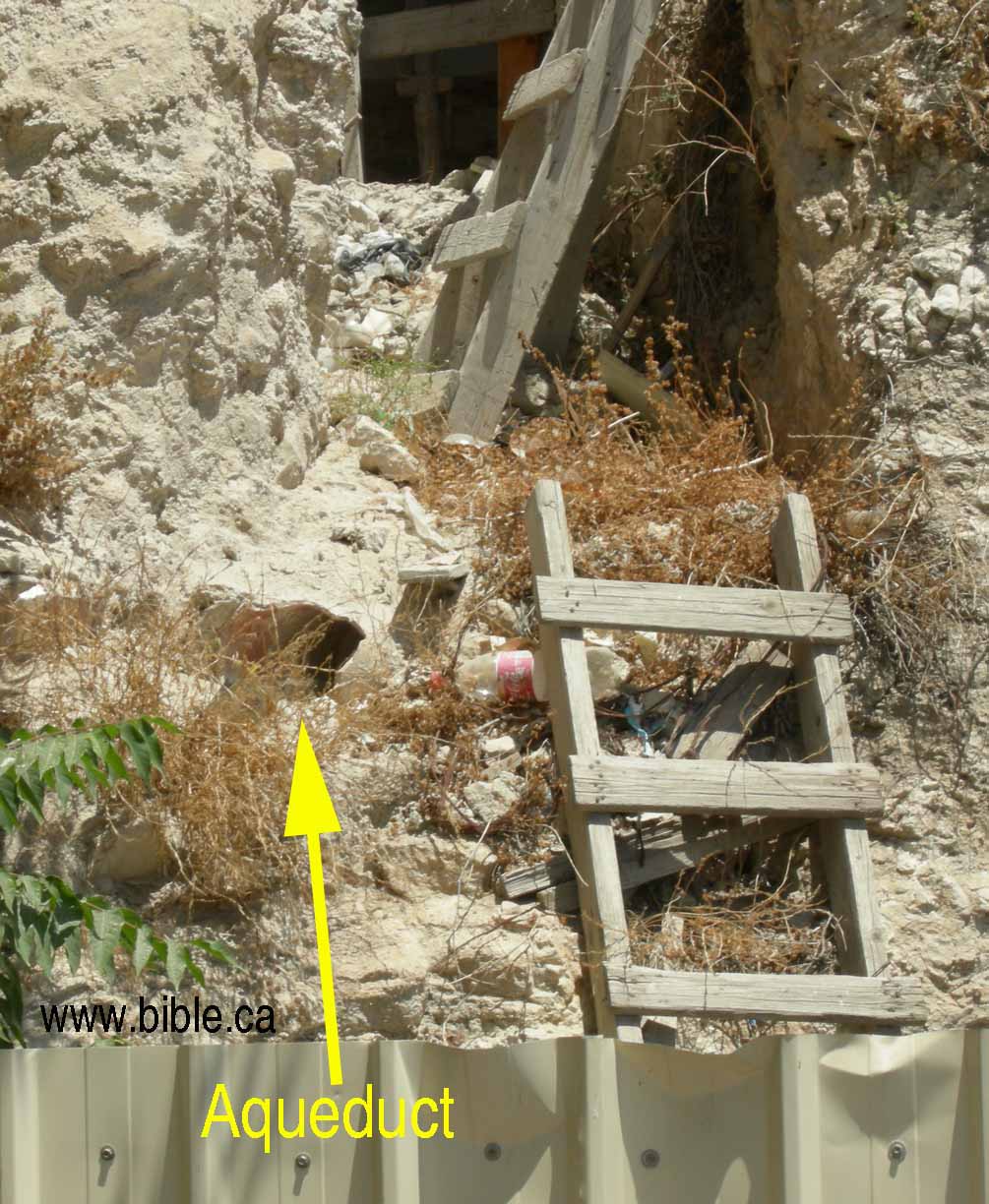
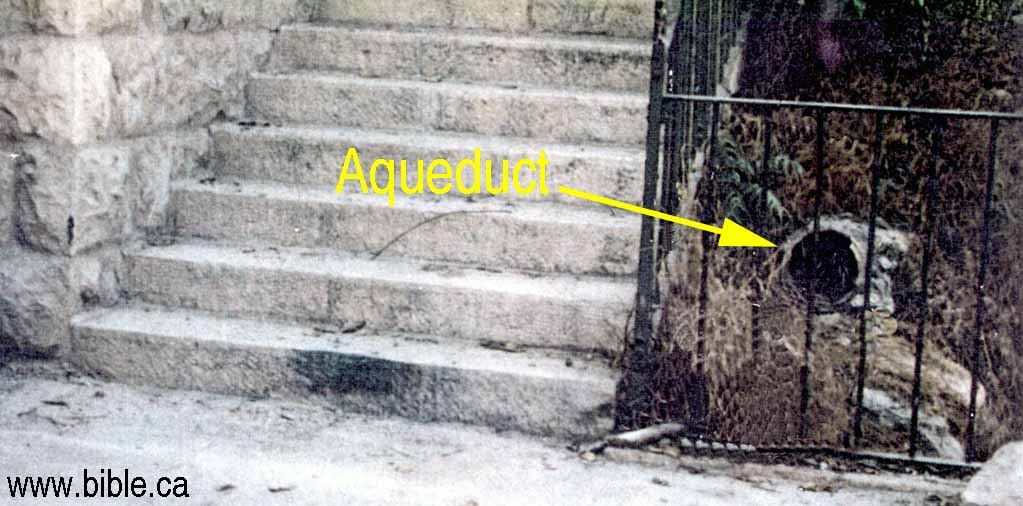
9.
Temple located
under the Al-Kas Fountain and over the
threshing floor We believe that the temple of Solomon was indeed located
10-20 meters below the Al-Kas fountain halfway between the Dome of the Rock and
the Al-Aqsa mosque. However, the fact that the aqueducts are broken off at
least 20 meters too low to supply the current temple, is not really proof that
the temple platform is too high today. We believe that it was indeed 10-20
meters lower in the time of Jesus, you just cannot use the level where the
aqueducts end as proof. The reason is simple. If they used a sealed siphon to
get the water across the 6 mile valley between Bethlehem and the temple mount,
they just continued the "garden hose" right up to the top of the
temple mount! What we see today is not all there was in the past. Obviously
then, if we continued the sealed siphon aqueduct from where we see it broken
today up to the Temple, there would be a at least 21 meters (65 feet) of
"gross" head. We would hardly think that Solomon would not have done
such, if it was required, regardless of the level of the temple platform.
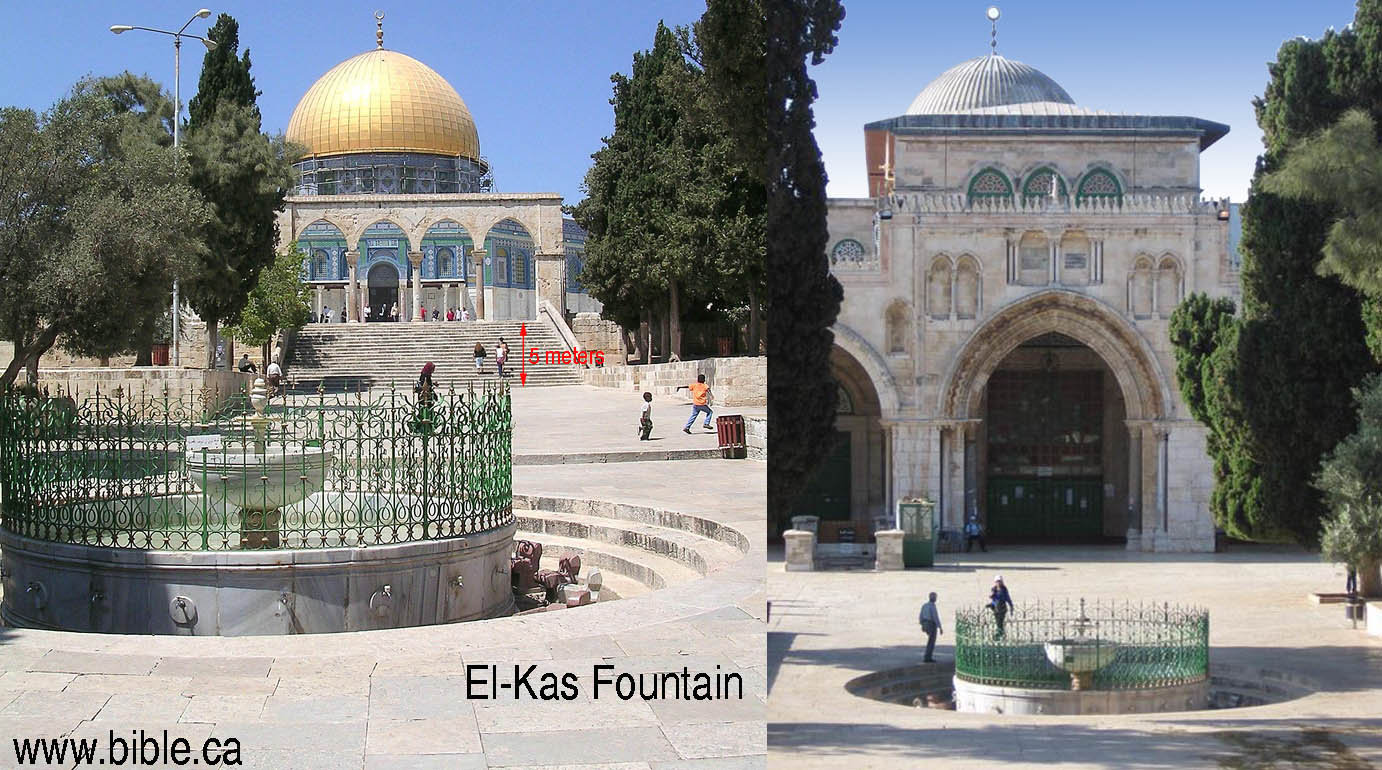
10. "The Temple Court was in all a hundred and eighty-seven cubits long and a hundred and thirty-five cubits wide. From east to west it was a hundred and eighty-seven cubits: the place which the Israelites trod was eleven cubits; the place which the priests trod was eleven cubits; the Altar thirty-two; between the Porch and the Altar was twenty-two cubits; the Sanctuary a hundred cubits, and eleven cubits behind the place of the Mercy Seat. From north to south was a hundred and thirty-five cubits: the Ramp and the Altar measured sixty-two; from the Altar to the rings was eight cubits; the place of the rings was twenty-four; from the rings to the tables was four cubits; from the tables to the pillars four; from the pillars to the wall of the Temple Court was eight cubits; and the remainder lay between the Ramp and the wall and in the place of the pillars. There were six chambers in the Temple Court, three to the north and three to the south. Those to the north were the Salt Chamber, the Parwah Chamber, and the Rinsing Chamber. In the Salt Chamber they put the salt for the offerings; in the Parwah Chamber they salted the hides of the animal-offerings, and on its roof was the place of immersion for the High Priest on the Day of Atonement. The Rinsing Chamber [was so named] because there they rinsed the inwards of the animal-offerings; and a passage-way led from it to the roof of the Parwah Chamber. Those to the south were the Wood Chamber, the Golah Chamber, and the Chamber of Hewn Stone. 'The Wood Chamber' — R. Eliezer b. Jacob said: I forget what was its use. Abba Saul [b. Batnith] said: It was the chamber of the High Priest and it lay behind the other two; and the roof of the three of them was on the same level. 'The Golah Chamber' — the Golah cistern was there, and a wheel was set over it, and from thence they drew water enough for the whole Temple Court. 'The Chamber of Hewn Stone' — there used the Great Sanhedrin of Israel to sit and judge the priesthood; and if in any priest a blemish was found he clothed himself in black and veiled himself in black and departed and went his way; and he in whom no blemish was found clothed himself in white and veiled himself in white, and went in and ministered with his brethren the priests. And they kept it as a festival-day for that no blemish was found in the seed of Aaron the priest. And thus used they to say: 'Blessed be God, blessed be he! for that no blemish has been found in the seed of Aaron. And blessed be he that chose Aaron and his sons to stand and serve before the Lord in the House of the Holy of Holies!'" (The Mishnah - Middoth Perek, V. 4, 5:1-4)
Faulty aqueduct argument:
1. Some use the fact that the end of the aqueduct today is (737m) is over 20 meters too low to freely flow by gravity to serve either the Azarah or the Water Gate. Tuvia Sagiv states it this way: "There are no water facilities near the Temple Mount which can supply water by means of gravity to the High Priest's ritual bath (Mikveh), according to all the known water systems except the Northern system - which would lower the level of the Temple Mount by 20 meters." (Lecture in Jerusalem, June 2006)
2. The problem with this conclusion is the phrase: "by means of gravity".
3. Yes, by gravity there is no way for water to flow from the current end of the aqueduct to serve the Temple unless of level of the platform is lowered by 20 meters. But we know that Solomon used a sealed siphon through the Bethlehem/Jerusalem valley not simple gravity to transport the water. Obviously then, this almost certainly not the original end of the sealed siphon aqueduct, which has long been destroyed.
4. Most importantly, there was enough "head" from Solomon's Pools in Etam, to bring water to the highest point, anywhere on the temple mount. In other words, if we hooked up a modern water hose to the end of the aqueduct at the 737m, it would have enough pressure (30 PSI actually!) to bring water above the temple platform we see today.
5. There is better evidence the temple was located 20 meters below the Al-Kas fountain than the gravity feed from the current end of the aqueduct argument. We need to drop the aqueduct argument because it is as invalid as it is weak and focus on better evidence.
Technical engineering Tables:
Water Facilities around the Temple Mount and Jerusalem: 30.48 cm = 1.0 feet
|
Subject |
Level in meters above sea level |
Sources and Notes |
|
A. Level of the Solomon's Pools at Ein Eitan |
765.0 |
"Ancient Water Aqueduct" p 187, A. Mazar. "Bethlehem Survey of the Water Aqueduct to Jerusalem" |
|
B. Level of Upper Aqueduct in Jerusalem |
760.0 |
"Ancient Water Aqueduct" p 187, A. Mazar. "Bethlehem Survey of the Water Aqueduct to Jerusalem" |
|
C. Level of the Lower Aqueduct in the Jewish Quarter |
737.6 |
Survey by Caspi. Warren, map No. XXVI (This level is mentioned in the survey of the water aqueduct, p. 187, but it is incorrect.) |
|
D. Level of the Lower Aqueduct at the Temple Mount |
737.5 |
Calculated assuming a 0.1% grade for open air, gravity flow. |
|
E. Level of the Israel Pool at the apex of the water level |
716.3 |
Warren, "Underground Jerusalem," p 346 |
|
F. Level of the Israel Pool at the apex of the wall |
734.8 |
Warren, map No. XVI |
|
G. Level of the Hasmonean Aqueduct near the Western Wall |
734.38 |
Survey by Sharon |
|
H. Level of the Struthion Pool at the water outlet |
740.3 |
Survey by Sharon |
|
I. Level of the Northen Aqueduct near the Struthion Pool |
741.0 |
Graphic Survey |
Elevations on Mount Moriah (Harem Es-Sharif): 30.38 cm = 1.0 foot
|
Subject |
Levels in meters above sea level |
Sources and Notes |
|
A. Level of the rock in the Dome of the Rock |
743.7 |
Warren, map No. XII |
|
B. Level of the Dome of the Spirits |
742.0 |
Warren, map No. IV |
|
C. Level of the Upper Court |
742.0 |
Warren, map No. XII |
|
D. Level of the Gate the Chain |
737.3 |
Warren, map No. XXXIV |
|
E. Level of the Mugrabim Gate |
736.4 |
Warren, map No. XXXII |
|
F. The approach of Robinson's arch |
727.1 |
Warren, map No. XXVII |
|
G. The approach of Wilson's arch |
728.9 |
Warren, map No. XXXIV |
|
H. Height of the apex of Wilson's arch |
735.3 |
Warren, map No. XXXII |
|
I. Height of the apex of Barclay Gate |
731.06 |
Warren, map No. XXXIV |
|
J. Height of the base of Barclay Gate |
721.3 |
Warren, map No. XXXII |
|
K. Height of the base of the Double Gate |
725.4 |
Warren, map No. XX |
|
L. Height of the base of the Triple Gate |
725.4 |
Warren, map No. XXVI, XXVII |
|
M. Height of the base of Warren Gate |
- |
Unknown Source |
|
N. Level of the rock at El Omariah |
749.8 |
Warren, map XXVII |
|
O. The foot of the rock at El Omariah |
741.2 |
Wilson, map No. 1864 Warren, map No. XXXVII |
Conclusion:
1. The Letter of Aristeas gives us solid proof that the aqueduct was in full operation as early as 278 BC.
a. This proves that the Hasmoneans (100 BC) and Romans (18 BC) were not the first builders of the water system, but mere renovators of an earlier design and build.
b. This is good evidence that Solomon was in fact the original designer and builder of the water system from Etam to his Jerusalem temple.
2. Ancient engineering skills in water transportation were amazing.
a. The ability to make water flow downhill along the contour of the land is a hugely complicated and tedious skill.
b. Designing, manufacturing and installing the closed syphon across the valley between Jerusalem and Bethlehem using sections of rocks cut into the shape of interconnecting pipe was a major accomplishment.
3. Although the temple of Solomon was likely 50 feet below the current temple platform, the water from Solomon's pools would easily supply water to the top of the modern temple platform we see today:
a. The level at Solomon's Pools near Bethlehem is 765 meters above sea level.
b. The level at the top of the Rock under the Dome is 744 meters.
c. We know Solomon used a sealed conduit system, so we know there was ample water pressure to supply lots of water to the temple mount based on the laws of physics including a friction loss calculation. Its really that simple.
d. Imagine a water tower installed on the temple platform that is 21 meters (69 feet) in the air.
e.
Technically speaking, the Pools of Solomon at Etam
could provide 21 meters of "head" produces about 30 PSI.

4. Solomon may have built the Etam pools and aqueduct.
a. Some wrongly conclude that just because we have connected the construction of the pools and aqueduct with the Hasmoneans (Maccabees) and the Romans, that Solomon did not build one or all three of the pools at Etam.
b. After 800 years upgrades or repairs would involve digging up the old system and replacing it with a new and larger water system.
c. Hasmonean and Roman construction would need to follow EXACTLY the same route as Solomon's original aqueduct.
d. Hasmonean and Roman construction would destroy and discard Solomon's work when the new system was installed.
e. Letter of Aristeas, written in 150 BC, describes the aqueduct. But since the letter is a Pseudepigrapha, he is claiming the aqueduct was in full operation as far back as 278 BC: "The Temple faces the east and its back is toward the west. The whole of the floor is paved with stones and slopes down to the appointed places, that water may be conveyed to wash away the 89 blood from the sacrifices, for many thousand beasts are sacrificed there on the feast days. And there is an inexhaustible supply of water, because an abundant natural spring gushes up from within the temple area. There are moreover wonderful and indescribable cisterns underground, as they pointed out to me, at a distance of five furlongs all round the site of the temple, and each of them has countless pipes 90 so that the different streams converge together. And all these were fastened with lead at the bottom and at the sidewalls, and over them a great quantity of plaster had been spread, and every part of the work had been most carefully carried out. There are many openings for water at the base of the altar which are invisible to all except to those who are engaged in the ministration, so that all the blood of the sacrifices which is collected in great quantities is washed away in the twinkling of an 91 eye. Such is my opinion with regard to the character of the reservoirs and I will now show you how it was confirmed. They led me more than four furlongs outside the city and bade me peer down towards a certain spot and listen to the noise that was made by the meeting of the waters, so that the great size of the reservoirs became manifest to me, as has already been pointed out." (R.H. Charles-Editor, Oxford: The Clarendon Press, 1913) (Letter of Aristeas 83-91, Pseudepigrapha of Greek Court-official 278-270 BC. Actual: Written by Jew in 150 BC)
5. While we cannot be sure that Solomon build the pools at Etam and the Aqueduct, it is a mistake to say that he did not build them.
a. It is a mistake to referring to the three Etam reservoirs as the "so called pools of Solomon" or "misnamed pools of Solomon" or "wrongly called Solomon's pools".
b. On the other hand, it is also possible that the pools were first carved about 100 BC and that Solomon had nothing to do with them.
c. Perhaps in time, we will find clarity through further archeological discovery.
6. See also: Solomon's Temple was not located "Over the Gihon Spring" because you don't put a toilet beside your kitchen table. (read more)
By Steve Rudd: Contact the author for comments, input or corrections.
